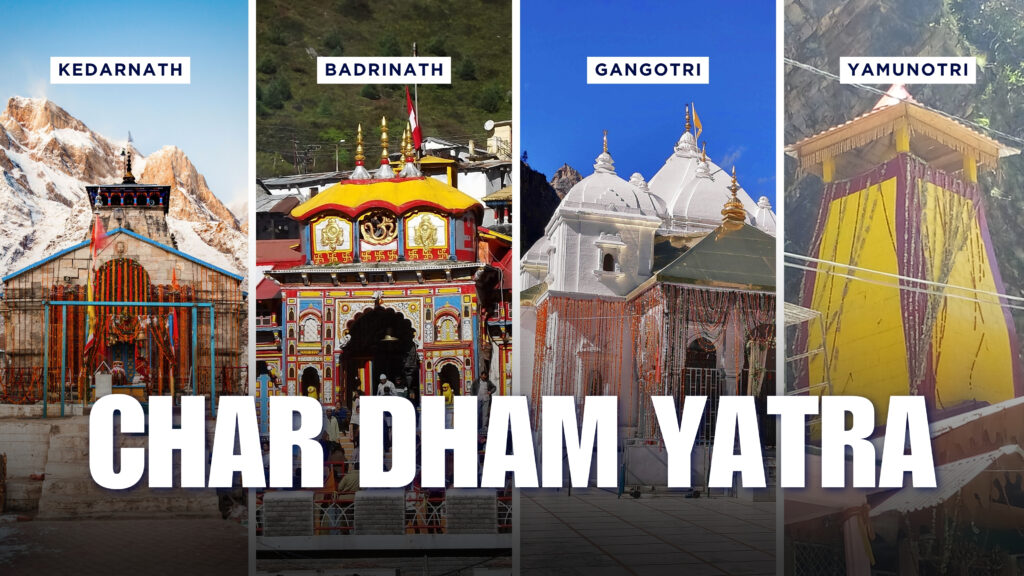Uttarakhand, often called “Devbhoomi” (Land of Gods), the state of serene beauty nestled in the lap of the Himalayas. This’s a place where snow-capped peaks touch the sky, ancient rivers carve deep valleys and spiritual vibrations fill the air. More than just a tourist spot, Uttarakhand is a sacred land for millions, a haven for adventurers and a unique blend of mountain culture and modern development.
Join us on a peaceful yet exciting journey through Uttarakhand, exploring its deep history, rich culture, stunning nature, and its path forward.

Uttarakhand’s Old History
Uttarakhand’s history is as old as its mountains. Ancient Hindu scriptures and epics like the Mahabharata mention this region as a significant spiritual land. Many sages and deities are said to have meditated here.
Through the ages, the region was ruled by various local kingdoms like the Katyuris, Chand Rajas and Parmars, each leaving their mark on its temples and traditions. The Garhwal and Kumaon regions, which make up the state, had distinct histories but shared common cultural threads. Later, parts of it came under the rule of the Gorkhas from Nepal and then the British.
Uttarakhand gained its separate statehood on November 9, 2000, by being carved out from Uttar Pradesh. This was a result of a long-standing movement by the local people who wanted better development and recognition for their unique mountain identity and challenges.
Uttarakhand’s Culture
Uttarakhand’s culture is deeply connected with Himalayan setting and its strong spiritual roots. It’s simple, honest, and full of faith.
- Festivals: Most festivals here are linked to nature, farming or religious events. Kumbh Mela held in Haridwar every 12 years, is a huge gathering of people for spiritual bathing. Other important festivals include Basant Panchami, Phool Dei, and Ganga Dussehra.
- Folk Dances & Music: The music and dances are simple, rhythmic and often tell stories of daily life, devotion or bravery. Popular folk dances include Chholiya, Langvir Nritya and Pandav Nritya. Folk songs are often sung during festivals, weddings and farming activities, often accompanied by instruments like the dhol, damau and flute.
- Traditional Attire & Crafts: The traditional dress is modest and practical for the mountain weather. Women wear ghaghra-pichora, while men wear kurta-pajama with a topi. Crafts reflect local resources: wood carving is excellent, seen in temple doors and house facades. Other crafts include traditional woolen products (like pankhi or blankets), Aipan and various bamboo and cane products.

Nature’s Masterpiece
Uttarakhand is a state of incredible natural beauty, offering a wide range of landscapes:
- High Himalayan Peaks: In the north, it boasts some of India’s highest and most sacred peaks, including Nanda Devi (a UNESCO World Heritage Site), Kamet and Trishul. These towering mountains feed numerous glaciers.
- Glacial Rivers: The state is the source of India’s two most sacred rivers: the Ganga (originating from Gaumukh) and the Yamuna (originating from Yamunotri). Their clean, cold waters flow down to the plains, supporting millions.
- Lush Valleys & Foothills: The lower regions, known as the Terai and Bhabar belts, are rich in forests and fertile land. Famous valleys include the Valley of Flowers (another UNESCO World Heritage Site), which explodes with thousands of floral species during monsoon.
- Hill Stations: Uttarakhand is dotted with popular hill stations like Nainital, Mussoorie, Ranikhet and Auli.
Uttarakhand is very rich in wildlife and forests, covering a large part of its area:
- Jim Corbett National Park: India’s oldest national park, famous for its tigers, elephants, and rich biodiversity. It’s a prime destination for wildlife safaris.
- Rajaji National Park: Known for its large elephant population.
- Valley of Flowers National Park: A UNESCO site famous for its unique alpine flowers and elusive wildlife like the snow leopard and Asiatic black bear.
- Nanda Devi Biosphere Reserve: A high-altitude reserve encompassing Nanda Devi National Park, home to rare Himalayan species.
However, the fragile Himalayan environment faces significant challenges:
- Climate Change: Glacial melt, unpredictable weather patterns, and extreme rainfall events are increasing, leading to disasters like landslides and flash floods.
- Deforestation & Landslides: Development activities, road construction, and sometimes illegal logging contribute to deforestation, making the slopes unstable and increasing landslide risks.
- Waste Management: Growing tourism brings challenges in managing waste, especially in popular hill stations and trekking routes.
- Water Scarcity in Hills: Ironically, while rivers flow from the mountains, many hill villages face water shortages due to drying springs and improper water management.
The state government is focused on sustainable development, disaster management, afforestation drives, and promoting eco-tourism to protect its delicate ecosystem.
Livelihood and Economic Development
Traditionally, the livelihood in Uttarakhand has been heavily dependent on agriculture, primarily subsistence farming on terraced fields. Crops like wheat, rice, maize, and various pulses are grown. Horticulture and herbal farming are also significant.
However, the state’s economy is increasingly diversifying, with key growth sectors:
- Tourism: This is the undisputed backbone of Uttarakhand’s economy, providing livelihoods to millions directly and indirectly. Pilgrimage tourism, adventure tourism, and nature tourism are major drivers.
- Hydro-Power Generation: With its numerous rivers, Uttarakhand has immense potential for hydroelectric power, and several dams and power projects contribute significantly to its energy supply and economy.
- Forest-based Industries: Timber, resin, and other forest products contribute to local economies.
- Manufacturing: Industrial areas in the plains have seen growth in pharmaceuticals, automotive components, and food processing, benefiting from government industrial policies.
- Service Sector: Growth in education, healthcare, and IT services is steadily increasing.
The state government is actively promoting investment through policies aimed at “Ease of Doing Business,” especially in tourism, renewable energy, and agro-processing, to boost the Gross State Domestic Product (GSDP) and create employment opportunities.
Hospitality and Tourism
Uttarakhand’s hospitality is legendary, often rooted in the concept of welcoming pilgrims and travelers to sacred lands. The people are known for their warmth, simplicity, and helpful nature, making visitors feel truly at home. This inherent friendliness greatly enhances the tourism experience.
The state is a major tourist destination, drawing millions seeking spiritual solace, adventure, or peaceful retreats:
- Pilgrimage (Char Dham Yatra): The revered pilgrimage circuit of Badrinath, Kedarnath, Gangotri and Yamunotri draws countless devotees seeking spiritual purification. Haridwar and Rishikesh are also major spiritual centers, famous for their Ganga aarti (river worship ceremony) and yoga ashrams.
- Adventure Tourism: Uttarakhand is an adventurer’s paradise.
- Trekking & Mountaineering: Routes to Roopkund, Valley of Flowers, Kedarkantha, and numerous Himalayan peaks.
- River Rafting & Kayaking: The Ganges in Rishikesh is a world-famous spot for white-water rafting.
- Skiing: Auli offers excellent skiing slopes with stunning Himalayan views.
- Bungee Jumping & Ziplining: Rishikesh has become an adventure sports hub for these activities.
- Nature & Hill Stations:
- Nainital: A beautiful lake town surrounded by hills.
- Mussoorie: The “Queen of Hills,” offering panoramic views.
- Jim Corbett National Park: For wildlife safaris and tiger sightings.
- Valley of Flowers: A vibrant carpet of alpine flowers.
- Pachmarhi: A peaceful hill station in the Satpura ranges.
The tourism infrastructure is continuously developing, with a range of accommodations from budget guesthouses to luxury resorts, catering to diverse visitor needs.
Uttarakhand’s Culinary Delights
Uttarakhand’s cuisine is simple, nutritious, and perfectly suited to the mountain climate. It emphasizes local ingredients and minimal spices, often using pulses and coarse grains.
- Garhwali Cuisine: Features dishes like Kafuli, Chainsoo, Fannah and Arsa.
- Kumaoni Cuisine: Known for Bhatt ki Churkani, Dubuk, Kumaoni Raita and Bal Mithai.
- Staples: Wheat and rice are common, often accompanied by various dals (lentils) and seasonal vegetables.
- Unique Ingredients: Local herbs like Jakhiya and Bhangjeera are used for tempering, adding distinct flavors. Millets like Mandua (finger millet) and Jhangora (barnyard millet) are important parts of the diet.
- Sweets: Besides Bal Mithai, Singori (a cone-shaped sweet wrapped in a maloo leaf) is also popular.
Challenges and The Future
Uttarakhand faces a unique set of challenges due to its fragile Himalayan ecosystem and developmental aspirations:
- Disaster Management: The state is highly prone to natural disasters like landslides, flash floods, and earthquakes. Building resilient infrastructure and effective early warning systems are crucial.
- Sustainable Development: Balancing the need for economic growth with the imperative to protect the delicate mountain environment.
- Migration from Hills: Many people from remote hill villages migrate to plains in search of better livelihood and facilities, leading to “ghost villages” and depopulation in some areas.
- Rural Development: Ensuring access to quality education, healthcare, and infrastructure in remote mountainous regions.
- Waste Management: The increasing tourist footfall exacerbates waste management challenges, particularly in sensitive ecological zones.
However, Uttarakhand has a clear vision for its future, focusing on sustainable and inclusive growth:
- Green Economy: Prioritizing eco-tourism, organic farming, and renewable energy (solar, small hydro) to ensure development is environmentally sound.
- “Reverse Migration” Initiatives: Creating opportunities in the hills through schemes promoting local entrepreneurship, homestays, and value-added agricultural products to encourage people to stay or return.
- Disaster-Resilient Infrastructure: Investing in safer roads, bridges, and housing.
- Horticulture & Herbal Sector: Boosting these sectors for higher farmer incomes and sustainable livelihoods.
- “Chardham All-Weather Road” Project: Improving connectivity to major pilgrimage sites to enhance tourism and local economies.
The Unfolding Peace of the Himalayas
Uttarakhand is a state that offers much more than just stunning scenery. It’s a journey into India’s spiritual heart, a challenge for the adventurous, and a serene escape for those seeking peace amidst nature. Despite the formidable challenges posed by its unique geography and the demands of development, the resilience of its people, their deep faith, and the state’s strategic focus on sustainable growth ensure that Uttarakhand will continue to shine as India’s cherished Land of Gods, forever inviting souls to its tranquil, majestic peaks.




